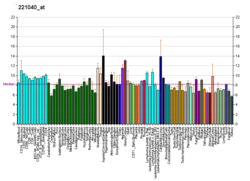Top Qs
Timeline
Chat
Perspective
CAPN10
Protein-coding gene in humans From Wikipedia, the free encyclopedia
Remove ads
Calpain-10 is a protein that in humans is encoded by the CAPN10 gene.[5][6]
Remove ads
Overview
Calpains are ubiquitous, well-conserved family of calcium-dependent, cysteine proteases. The typical calpain proteins are heterodimers consisting of an invariant small subunit and variable large subunits. The large catalytic subunit has four domains: domain I, the N-terminal regulatory domain that is processed upon calpain activation; domain II, the protease domain; domain III, a linker domain of unknown function; and domain IV, the calmodulin-like calcium-binding domain. The heterodimer interface is predominantly found between domain IV and the small subunit, which is also a calmodulin-like calcium-binding domain. This gene encodes a large subunit. It is an atypical calpain in that it lacks the calmodulin-like calcium-binding domain and instead has a divergent C-terminal domain. It therefore cannot heterodimerize with the small subunit. It is similar in organization to calpains 5 and 6. This gene is associated with type 2 or non-insulin-dependent diabetes mellitus (NIDDM) and located within the NIDDM1 region. Multiple alternative transcript variants encoding different isoforms have been described for this gene.[7]
Remove ads
References
Further reading
External links
Wikiwand - on
Seamless Wikipedia browsing. On steroids.
Remove ads






